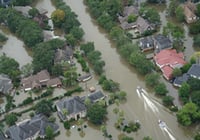 The full economic impact of Hurricane Harvey has yet to be completely calculated, but financial experts all agree that Hurricane Harvey will go down in history as one of the most, if not the most, expensive natural disasters in the nation’s history.
The full economic impact of Hurricane Harvey has yet to be completely calculated, but financial experts all agree that Hurricane Harvey will go down in history as one of the most, if not the most, expensive natural disasters in the nation’s history.
Moody’s estimates that property losses will total between $45 billion to $65 billion, with economic losses adding another $6 billion to $10 billion. This $75 billion estimate would make Hurricane Harvey second to only Hurricane Katrina’s $118 billion price tag. Some reports estimate that the final price tag of Hurricane Harvey could reach $160 billion due to its massive impact on Houston, the nation’s fourth largest city.
====
Editor’s Note: There are many ways to help those affected by Hurricane Harvey. Below are a few charities that have coordinated aid and relief:
Also, with Hurricane Irma, currently a Category 5 storm, estimated to make landfall in South Florida on Sunday morning, the above charities (and many other reputable charities) will need your support more than ever. Please consider donating.
====
When natural disasters hit, we’re often reminded about the importance of business continuity so organizations can continue to service patients and clients in times of need and keep their operations up and running. There are several ways to protect your organization from Mother Nature’s worst:
1) Migrate your entire IT infrastructure to the cloud
For organizations that manage their entire IT infrastructure on-premises, there are few scenarios scarier than a natural disaster. If your organization loses power (as many in Texas and Louisiana have with Hurricane Harvey), your entire infrastructure is held hostage until power is restored. Even onsite power backup systems that rely on stored fuel, or municipal gas supply, are failing during this multi-week event. This cripples business operations and puts you at severe risk of data and business loss. Conversely, if your entire infrastructure is in the cloud, you don’t have to worry about the safety and availability of your data. Cloud migration can be tricky, so you’ll want to make sure you’re working with a partner who can help you safely migrate to the cloud.
2) Set up your team for remote working
Have a contingency plan in case you lose power at your location(s), especially if there is work that your teams can do from battery-powered laptops and mobile devices. If your infrastructure is cloud-based, your team will be able to access files and applications from wherever they can connect to the internet, whether that’s at home or a temporary pop-up office you establish 200 miles away. To effectively execute a mobility strategy, you’ll need to rely on the security, performance and delivery knowledge that an experienced cloud-migration team brings you.
3) Frequently back up data and have a disaster recovery plan
With today’s weather forecasting technology, we might get advanced notice of a pending natural disaster, but it is often not enough time to completely batten down the hatches on your data systems. Make sure you have frequently scheduled data backups and a solid disaster recovery plan so you’re always prepared, no matter what Mother Nature throws at you.
4) Plan for redundancies
No one can predict what will happen when natural disasters strike, but you can at least plan for worst-case scenarios, especially with your telecommunications. By having redundancies and fail-over systems in place with multiple telecom providers, you protect yourself in case one of the telecom providers experiences an outage. We’ve seen this occur with several of our clients, and rather than being down during inclement weather, we quickly switched them over to their fail-safe connections so they stayed up and running.
5) Discuss. Plan. Document. Practice.
The steps discussed above will put the systems in place to help your business weather a storm, when IT is critical to your operations – but your people need to execute. A seamless execution of a disaster-recovery plan is something you hope to never experience, but you should prepare for it nonetheless. Careful discussion of the risk points should be followed by a documented plan that’s disseminated to all relevant levels of the organization. Too many organizations have a Disaster Recovery plan that’s limited to the IT team, or the Facilities Team, which means that others in the organization may not know their roles in a challenging disaster. Once a plan is in place, and disseminated, one or two practice rounds is in order. If not a full disaster drill (it can be difficult), then consider some spot-testing of key systems.
Today, we rely so much on technology that it’s easy to forget to plan for those scenarios that try to take that technology away from us. But, with the right planning and infrastructure, you can help mitigate the impact of a natural disaster on your organization so you can stay up and running in the face of disaster.
 Support
Support Contact Us
Contact Us



